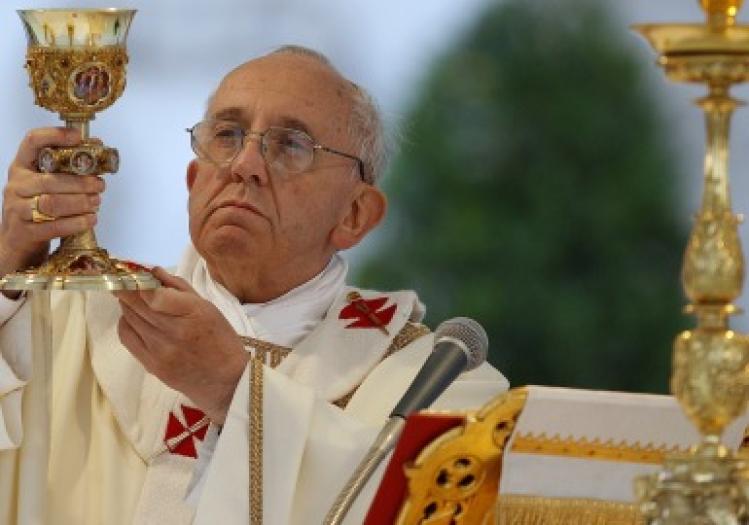
The results of a recent survey by the Center for Applied Research in the Apostolate indicate that more than half the priests in the United States dislike the new Missal translation. A very large majority finds parts of it “awkward and distracting.” Many believe it urgently needs revision. Fr. Tony Cutcher, president of the Federation of Priests’ Councils, says it’s time to move forward with “constructive criticism” and changes. Atlanta Archbishop Wilton Gregory said much the same thing recently at a conference in Florida.
OK, I’m ready. Can we change “chalice” back to “cup” now?
The new translation retired the word “cup,” and replaced it with “chalice.” “Chalice” now occurs three times in the heart of the Mass, where Jesus’ actions at the Last Supper are described. In Eucharistic Prayer I, the Old Roman Canon, the current translation refers to the cup as “this precious chalice.”
When the word “chalice” first appeared, some people liked it. “Chalice” seemed special and more reverent to them than the simpler and more common word “cup.” Others disliked it because it brought to mind an ornate, bejeweled vessel, fine for princes but foreign to Jesus. What sort of drinking vessel would a Galilean rabbi use?
Supporters of “chalice” stood firm. They said the Latin calix simply means “chalice”—it’s a literal translation; get over it. Sadly, the notion of a “false friend,” an English word that sounds like the Latin word but isn’t quite the same, seems not to have occurred to them.
Is there anything more to be said? Well, yes.
There’s a liturgico-historical argument against “chalice,” and it’s a killer. It was produced in 2006 by an Australian scholar, Fr. Barry Craig. His research was presented at the Western Pacific Rim Patristic Society and published in Worship magazine in 2007: “Potency Not Preciousness: Cyprian’s Cup and a Modern Controversy.”
Craig focuses on Eucharistic Prayer I, and argues that “hunc praeclarum calicem” ought not to be translated “this precious chalice” because such a translation is directly opposed to what the fathers meant by the original Latin phrase. In translating liturgical texts, Latin poetry and patristic usage matter. The Vatican statement Liturgiam Authenticam directs that careful attention be paid to the history of interpretation of words and phrases, particularly those arising from the thought-world of the fathers that shaped our earliest liturgical history and practice.
Craig meticulously researched the historical background according to these principles. He found that the word praeclarus never means “precious.” Noble, outstanding, or potent, but not precious. His research devastatingly reveals that the sense of the English term “precious chalice” only appears a few times in the patristic literature. Whenever it does, it is used figuratively to describe the “precious chalice” of the heretics—i.e., the attractive cup from which false teaching is imbibed.
There’s more, too. According to Eucharistic Prayer I, Jesus took “this” cup in his hands. Why this cup? There was an early controversy concerning whether water might be used instead of wine in the Eucharist. The wine-water controversy provides the key to why the Roman canon says “this potent [i.e. alcoholic/spiritually inebriating] cup”—meaning wine. The vessel is plainly not the focus; its contents are. In English, the word “cup” can refer to both the vessel and what it contains. Not so “chalice.” You can drink from a chalice, but you cannot “drink a chalice.” If you are talking about the contents of the vessel, “cup” is the only word that works.
I think Craig nailed it. He’s certainly right about Eucharistic Prayer I. And once you’ve demolished “this precious chalice” it becomes harder—if not impossible—to justify translating calix as “chalice” in the other, modern Eucharistic prayers, no matter how well anyone likes it. Translators are rightly criticized when they import a faux-antique term into modern compositions.
If “chalice” is not required by the Latin language and it runs contrary to liturgical and patristic tradition, why are we saying it? The International Commission on English in the Liturgy does not account for its decisions, but a clue appeared in a footnote to the 2006 draft that was sent for review to the English-speaking bishops. This footnote explained that at certain points in the history of the English language Catholics favored “chalice” and Protestants favored “cup.” The inescapable inference is that the word “chalice” is preferred in order to perpetuate a dead distinction between Catholics and Protestants. But is this something we want to do today? Most Catholics would say no.
So here’s my constructive suggestion: Just say “cup.” It’s the right word.

